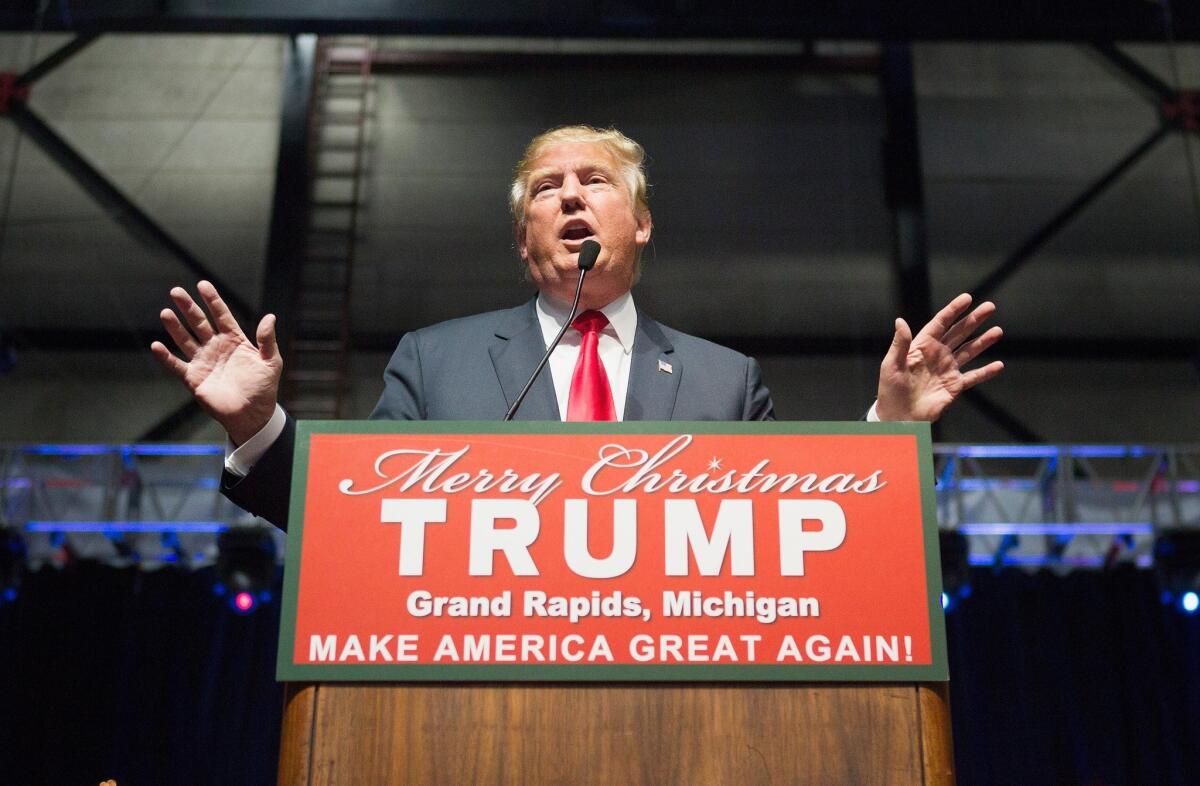Op-Ed: Why Donald Trump won’t run as a spoiler candidate

Republican presidential candidate Donald Trump speaks to guests at a campaign event on Dec. 21 in Grand Rapids, Mich.
- Share via
Voters’ disgust with the current political setup is firing Donald Trump’s presidential bid. Yet Trump has latched himself onto the epitome of politics-as-usual: the Republican Party and its primary process.
What’s keeping Trump, who is polling well among right-leaning independents, from making an independent run, GOP be damned?
Numerous polls and other data suggest that voters are eager for choices from outside the mainstream. More than half the respondents to a 2011 Gallup poll said they want a third party. In a 2014 Gallup poll, 42% of voters identified as independent — most lean left or right, but don’t want to be called Republicans or Democrats.
As Trump clearly knows, a third party/independent candidate is at best a spoiler, and at worst, a sore loser.
The race for the 2016 presidential nominations offers ample evidence that voters desire something new. Besides Trump, two other Republican contenders gained early momentum: former surgeon Ben Carson and business executive Carly Fiorina — neither of whom has held office or played a prominent political role. Sen. Bernie Sanders, the socialist-affiliated independent, is second only to Hillary Clinton in the Democratic race, easily besting more mainstream candidates. The popularity of outsiders suggests that the “anyone but the party guy” has a strong place in today’s political zeitgeist.
It’s odd that old-line parties remain in such control of presidential elections even as politics itself is being reinvented. Raising and spending money is easier than ever thanks to super PACs and looser campaign finance laws. Social media have made online organizing, campaigning and fundraising possible; if crowdfunding sites can collect millions to revive “Reading Rainbow,” surely a popular presidential candidate could raise cash. Add to those trends the segmentation of the news media and the ability of candidates to bypass mainstream outlets altogether, and it would seem that the ground is fertile for third-party candidates.
But the very structure of America’s presidential selection process remains essentially a closed binary system. Even when new parties spring up in America, they just supplant one of the current two. As Trump clearly knows, a third party/independent candidate is at best a spoiler, and at worst, a sore loser.
Consider the third-party campaigns of recent decades. Ralph Nader’s 2000 Green Party bid helped cost Al Gore the White House. Ross Perot’s independent run in 1992 damaged the campaign of losing incumbent George H.W. Bush. Neither Nader nor Perot captured a single electoral vote, nor did their positions have much influence on the winner’s future policies. What they did do was engender anger from past supporters.
You’d have to go back to 1968 and George Wallace to find a third-party candidate who managed to claim any electoral delegates at all. Since the Civil War only Teddy Roosevelt, the Progressive Party nominee in 1912, managed to come in second in a presidential run as a non-major party candidate.
Starting out in a primary and then switching to an independent run carries its own problems. “Sore losers” rarely get past the perception that they are just petulant. In 2012, former Utah Gov. Jon Huntsman floated and quickly abandoned the idea.
Occasionally a local or state candidate with party-crossover appeal can pull it off, though most states forbid a sore loser from appearing on the ballot a second time in the same election cycle. Sen. Lisa Murkowski and former Sen. Joe Lieberman both won with independent/write-in bids. But on the national level, a sore loser bid is a non-starter.
The very structure of the electoral college is a deterrent. Unlike most elections, in which a plurality of the popular vote is sufficient to win, the electoral college demands a presidential candidate get on the ballot and gain support in multiple regions of the United States. A candidate could win all the delegates from the former Confederacy, toss in California, Arizona, Nevada, West Virginia, New Mexico, Oklahoma and Kentucky, and it still wouldn’t add up to the 270 delegates needed to win.
Third-party runs meet disappointment so consistently, in part, because there aren’t as many truly “independent” voters as we like to think. Yes, 42% of voters aren’t registered with any party — but just 10% say they don’t lean toward one party or the other.
Furthermore, campaigns quash any potential spoiler: They co-opt popular proposals and hammer away at the new party’s inconsistent positions or the candidate’s inexperience. Soon voters retreat to the comfortable embrace of the traditional parties. Outsider candidates inevitably lose steam or collapse in the face of donor disinterest. In many states, there are also serious difficulties just getting on the ballot.
Trump’s political positions may be extreme, but his approach is pragmatic. If he wants to expand his real estate holdings to include 1600 Pennsylvania Ave., he’ll get there only via the GOP primary. He’s certainly too brand-conscious to risk the “sore loser” image. As for the millions of Americans who’d like to see the end of two-party rule, they shouldn’t hold their breath.
Joshua Spivak is a senior fellow at the Hugh L. Carey Institute for Government Reform at Wagner College in New York. He blogs at recallelections.blogspot.com.
Follow the Opinion section on Twitter @latimesopinion and Facebook
More to Read
A cure for the common opinion
Get thought-provoking perspectives with our weekly newsletter.
You may occasionally receive promotional content from the Los Angeles Times.









